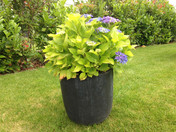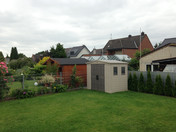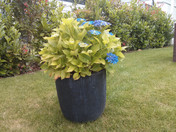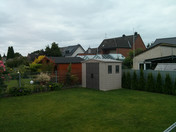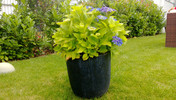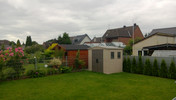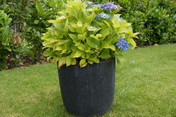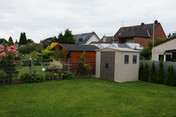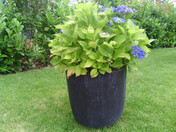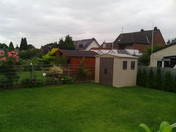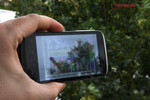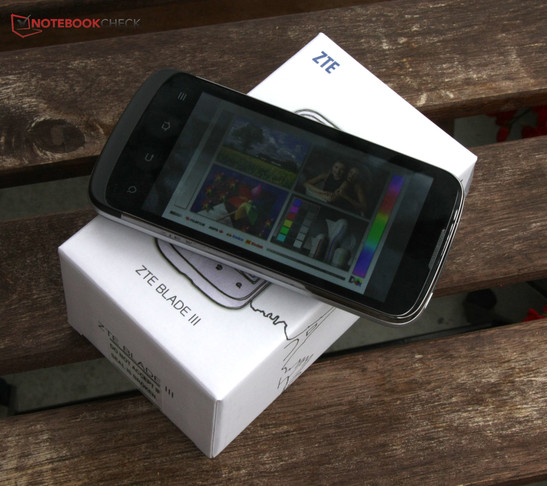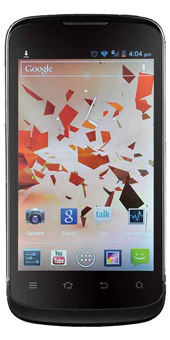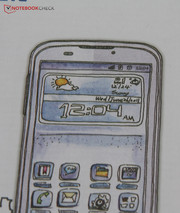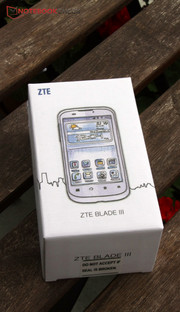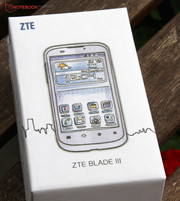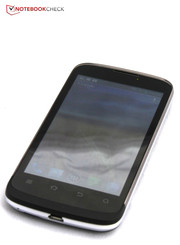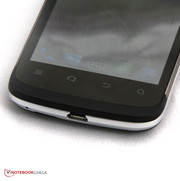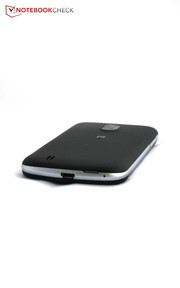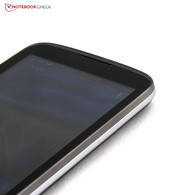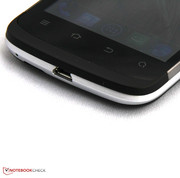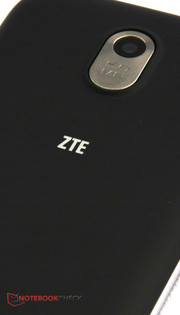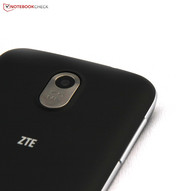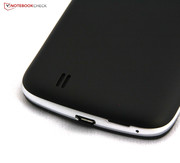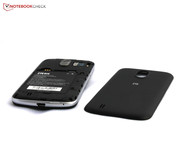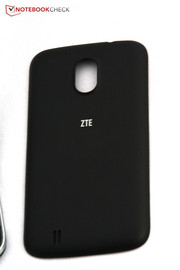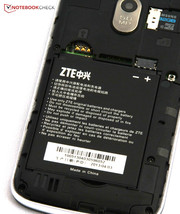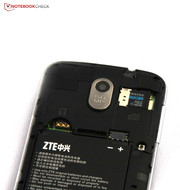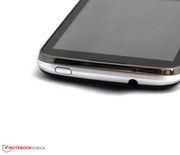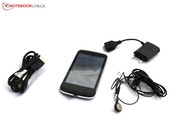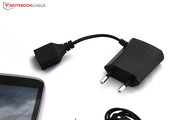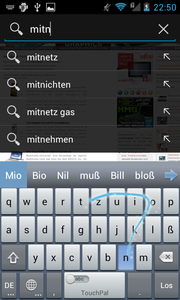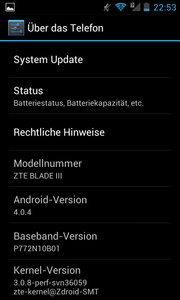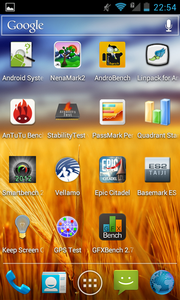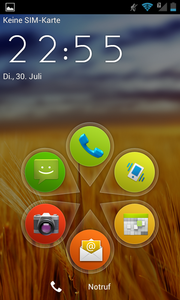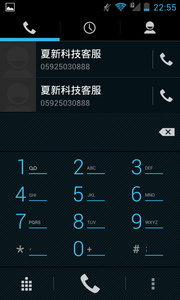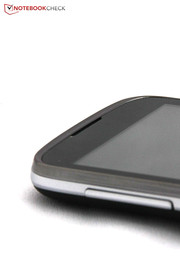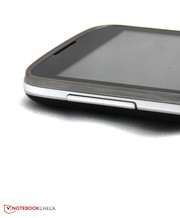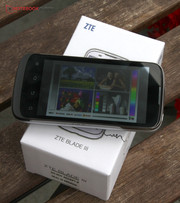Review ZTE Blade III Smartphone

For the original German review, see here.
Although ZTE is not as popular as Samsung or Sony in our regions, the Chinese company employs almost 90000 workers and sees itself among the top 5 of major cellphone manufacturers. We have reviewed the Grand X Pro and Grand X IN and were generally quite satisfied with the devices. However, the price difference to equivalent devices from better known manufacturers was not very big.
The ZTE Blade III that we are testing today is a very affordable entry-level model, which wants to compete with devices such as Sony's Xperia J or Acer's Liquid E1 Duo. We will also use Jiayu's G3, Huawei's Ascend W1, Huawei's Ascend Y300, Amoi's N828, Nokia's Lumia 520 and LG's Optimus L5 II for comparison. Find out how ZTE's Blade III fares in this community.
Case
The casing of ZTE's Blade III strongly resembles that of ZTE's Grand X IN although the latter is a bit bigger. The polycarbonate material and decent stiffness have been adopted. The phone cannot be warped and is absolutely pressure resistant. The build is also very good; the gaps are narrow and even.
The front and back of ZTE's Blade III is completely black. The encompassing, chrome-colored bezel features a small notch as an eye-catcher. Four touch-sensitive buttons are below the screen. Overall, the phone convinces more with its rigid build than its design, which is fairly plain and thus likely suitable for the masses.
Connectivity
ZTE's Blade III only includes the common interfaces. One USB 2.0 port and a 3.5 millimeter audio jack is all that is found. However, that is all that is needed. A slot for a micro-SD card with a maximum of 32 GB and the micro-SIM slot are underneath the removable back cover. The battery has to be removed before these slots can be accessed.
Software
The slightly older Android 4.0.4 is used as the operating system in our review sample. The manufacturer has not modified it much. Only the app Mi-EasyAcess is there to facilitate getting started. The user can access frequently used functions via the lock screen. ZTE now clearly points out that the phone can be unlocked by pressing the button for a longer time. This was very unclear before. The selection of preinstalled software is not vast. An office suite and file manager are the biggest add-ons.
Communication & GPS
The smartphone sends and receives in three different GSM bands so that it can be used in many cellphone-networks worldwide. ZTE's Blade II also supports all 3G technologies up to HSPA. Swift LTE is not available but that cannot be expected in an entry-level phone anyway.
The Wi-Fi module supports the 802.11 b/g/n standards. We checked whether the smartphone has enough reception power by separating the phone from the router with three walls and a distance of 10 meters. The Android display still exhibited two out of four bars. Another wireless interface is Bluetooth 2.1, which is an older version that lags behind the current standards in terms of security and speed.
A-GPS is also on-board. The module detected enough satellites to accurately determine our location outdoors. However, the reception could only be maintained for a short time indoors. Although there were still a few satellites within range, there weren't enough to perform localization.
Telephony
In line with the unmodified looks of the Android system, the phone app was not changed either. Die-hard Android users will feel at home right away, but everyone else will also quickly learn just how the intuitive app works.
The speech quality is acceptable. The called party comes across loud and clear and we were also intelligible. We did not ascertain excessive noise. However, the headset and speaker are barely suitable for calls. The headset exhibits a poor sound quality, is uncomfortable to wear and cannot completely cancel background noise. The speaker does not have a particularly high maximum volume and tends to hum.
Cameras & Multimedia
ZTE's Blade III only features one camera. There is no front-facing camera for video chats or self-portraits. The small lens on the rear has a resolution of 5 megapixels and, although autofocus is installed, it does not have an LED flash. Other phones from this price range, such as Sony's Xperia J, sport a front-facing camera even if the picture quality is usually not good enough for very much. Jiayu's G3 even has an 8 megapixel camera that shoots decent pictures in good light.
Our review sample shoots acceptable pictures that are however slightly overexposed and lack contrast in bright light. The details are still good even when zoomed. Overall, it is possible to take quite acceptable pictures with the camera. However, it should not be used in low light because of intense noise and the lack of a flash.
Accessories
Only the unusual power supply in form of a wall wart with a short cord and USB port, a USB cord and a headset are included. However, as mentioned above the latter is not of much use. ZTE does not have a webshop in Germany and there are no signs of device-specific accessories on the German website.
Warranty
A 24 month warranty is included. Warranty claims can be made over the retailer or ZTE's hotline. The latter is available on business days via a normal landline number.
Input Devices & Controls
The virtual keyboard shows a difference to the Android standard after all. ZTE installs a keyboard dubbed "TouchPal". We found this model in the reviews of the other two ZTE phones and were quite pleasantly surprised by its diverse input options. Voice input, swiping rather than tapping, display option for special characters, special menus for parts of internet addresses and a clipboard. In short, there are many customization options for the keyboard. It is even possible to download skins from the internet, which give the keyboard a wooden or leather look.
The touchscreen support gestures with up to five fingers. However, the finish is not as sleek as in other models. The volume rocker on the left features a good pressure point and its use conveys a high-quality, reliable feel. Only the standby button is a bit small and is difficult to find in the dark.
Display
The 4-inch screen in a 16:10 aspect ratio has a resolution of 480x800 pixels. It is based on TFT technology. Although the resolution is acceptable for a smartphone of this category, Jiayu proves that a 720p resolution is possible with its G3. But the differences would only be evident with a magnifying glass and the display of ZTE's Blade III looks throughout focused and rich in color.
Our review sample provides similar brightness rates as most contenders. An average of 333.6 cd/m² is ultimately only enough for a place in the midfield though. For example, Amoi's N828 and LG's Optimus L5 II are much brighter. The illumination of 88% is fairly even but brightness differences are quite visible in white or black areas.
| |||||||||||||||||||||||||
Brightness Distribution: 88 %
Center on Battery: 352 cd/m²
Contrast: 838:1 (Black: 0.42 cd/m²)
ΔE ColorChecker Calman: 6.09 | ∀{0.5-29.43 Ø4.77}
ΔE Greyscale Calman: 6.22 | ∀{0.09-98 Ø5}
Gamma: 2.68
CCT: 8029 K
The "mediocrity" of our review sample is continued in contrast and black value. A contrast of 838:1 and a black value of 0.42 cd/m² do not set standards although they are not really bad. As said before, the color reproduction is quite appealing. Nevertheless, black is not very saturated and looks like dark gray.
However, black is the value that deviates the least from the ideal value in the grayscale. We determined this using the colorimeter and CalMAN software. White deviates extremely from the ideal value and has a clear bluish cast. This bluish cast is noticed in the color management where blue is overemphasized. The saturation shows that red and blue are very unsaturated. Overall, the reproduction deviates extremely from the ideal sRGB color space and it is particularly the bluish cast that ruins the color representation.
ZTE's Blade III actually shows its advantages outdoors. The screen remains quite legible in bright light due to the decent brightness. However, that is very straining on the eyes. It is recommendable to look for a shady place or work indoors with the phone in the long run. The content is very legible then.
Performance
ZTE's Blade III is based on an SoC from Qualcomm. The Snapdragon S1 MSM7227A features an ARM Cortex A5 computing core and a clock rate of 1000 MHz. Sony's Xperia J, for example, uses the same central component. ZTE installs 512 MB of working memory; current premium devices partly sport four times as much.
Despite the identical hardware, Sony's Xperia J has the lead in the synthetic benchmarks. While there are hardly any differences in the system's overall performance, a clear difference is seen in the processor's pure performance. Sony's Xperia J calculates 50% faster than ZTE's Blade III. All other compared devices are also clearly before it.
The user will generally have to accept evident stutters in navigation and when using apps. Crashes were also frequent in demanding benchmarks.
| Smartbench 2012 - Productivity Index (sort by value) | |
| ZTE Blade III | |
| Sony Xperia J | |
| Jiayu G3 | |
| Huawei Ascend Y300 | |
| Amoi N828 | |
| LG E460 Optimus L5 II | |
| Acer Liquid E1 Duo | |
| Linpack Android / IOS | |
| Single Thread (sort by value) | |
| ZTE Blade III | |
| Sony Xperia J | |
| Jiayu G3 | |
| Amoi N828 | |
| LG E460 Optimus L5 II | |
| Acer Liquid E1 Duo | |
| Multi Thread (sort by value) | |
| ZTE Blade III | |
| Sony Xperia J | |
| Jiayu G3 | |
| Amoi N828 | |
| LG E460 Optimus L5 II | |
| Acer Liquid E1 Duo | |
| PassMark PerformanceTest Mobile V1 - System (sort by value) | |
| ZTE Blade III | |
| Acer Liquid E1 Duo | |
| AnTuTu v3 - Total Score (sort by value) | |
| ZTE Blade III | |
| Sony Xperia J | |
| Jiayu G3 | |
| Huawei Ascend Y300 | |
| Amoi N828 | |
| LG E460 Optimus L5 II | |
| Acer Liquid E1 Duo | |
| Geekbench 2 - 32 Bit - Total Score (sort by value) | |
| ZTE Blade III | |
| Sony Xperia J | |
| Jiayu G3 | |
| Huawei Ascend Y300 | |
| LG E460 Optimus L5 II | |
| Acer Liquid E1 Duo | |
| Quadrant Standard Edition 2.0 - --- (sort by value) | |
| ZTE Blade III | |
| Jiayu G3 | |
| Acer Liquid E1 Duo | |
An Adreno 200 integrated in the SoC is responsible for the graphics "power". We use quotation marks for power because it is not very high. All compared phones are much faster; only Sony's Xperia J based on identical hardware is on a par. The graphics unit also produced severe graphic bugs in a few benchmarks and even in a few games so that its suitability for demanding apps is doubtful.
| 3DMark | |
| 1280x720 Ice Storm Standard Score (sort by value) | |
| ZTE Blade III | |
| LG E460 Optimus L5 II | |
| 1280x720 Ice Storm Standard Graphics (sort by value) | |
| ZTE Blade III | |
| LG E460 Optimus L5 II | |
| 1280x720 Ice Storm Standard Physics (sort by value) | |
| ZTE Blade III | |
| LG E460 Optimus L5 II | |
| GFXBench (DX / GLBenchmark) 2.7 - T-Rex Onscreen (sort by value) | |
| ZTE Blade III | |
| Huawei Ascend Y300 | |
| Epic Citadel | |
| High Performance (sort by value) | |
| ZTE Blade III | |
| Jiayu G3 | |
| Huawei Ascend Y300 | |
| LG E460 Optimus L5 II | |
| Acer Liquid E1 Duo | |
| Acer Liquid E1 Duo | |
| High Quality (sort by value) | |
| ZTE Blade III | |
| Jiayu G3 | |
| LG E460 Optimus L5 II | |
| Acer Liquid E1 Duo | |
| NenaMark2 - --- (sort by value) | |
| ZTE Blade III | |
| Sony Xperia J | |
| Jiayu G3 | |
| Huawei Ascend Y300 | |
| Amoi N828 | |
| LG E460 Optimus L5 II | |
| Acer Liquid E1 Duo | |
ZTE's Blade III also clearly lags behind in the synthetic browser benchmarks. Even Sony's Xperia J has a 30% or higher lead in many benchmarks. We can confirm this result from real-life use of the smartphone. We repeatedly observed that pages load slowly and waiting times occur when scrolling.
| Vellamo Mobile Benchmark 2.0 | |
| HTML5 (sort by value) | |
| ZTE Blade III | |
| Sony Xperia J | |
| Jiayu G3 | |
| Huawei Ascend Y300 | |
| Amoi N828 | |
| LG E460 Optimus L5 II | |
| Acer Liquid E1 Duo | |
| Metal (sort by value) | |
| ZTE Blade III | |
| Sony Xperia J | |
| Jiayu G3 | |
| Huawei Ascend Y300 | |
| Amoi N828 | |
| LG E460 Optimus L5 II | |
| Acer Liquid E1 Duo | |
| Mozilla Kraken 1.0 - Total (sort by value) | |
| ZTE Blade III | |
| Sony Xperia J | |
| Jiayu G3 | |
| Huawei Ascend W1 | |
| Huawei Ascend Y300 | |
| Amoi N828 | |
| Nokia Lumia 520 | |
| Acer Liquid E1 Duo | |
| Peacekeeper - --- (sort by value) | |
| ZTE Blade III | |
| Sony Xperia J | |
| Jiayu G3 | |
| Huawei Ascend W1 | |
| Huawei Ascend Y300 | |
| Amoi N828 | |
| Nokia Lumia 520 | |
| LG E460 Optimus L5 II | |
| Acer Liquid E1 Duo | |
| Google V8 Ver. 7 - Google V8 Ver. 7 Score (sort by value) | |
| ZTE Blade III | |
| Sony Xperia J | |
| Jiayu G3 | |
| Huawei Ascend W1 | |
| Huawei Ascend Y300 | |
| Amoi N828 | |
| Nokia Lumia 520 | |
| LG E460 Optimus L5 II | |
| Acer Liquid E1 Duo | |
| Acer Liquid E1 Duo | |
| Acer Liquid E1 Duo | |
* ... smaller is better
Then again, the storage of ZTE's Blade III does not look quite as bad. It is located in the midfield of our comparison devices. Sony's Xperia J is much slower here and Huawei's Ascend Y300 also only accomplishes consistently lower transfer speeds. The loading times are acceptable in practical use. The user does not have as long waiting times as with other entry-level phones.
| AndroBench 3-5 | |
| Sequential Read 256KB (sort by value) | |
| ZTE Blade III | |
| Sony Xperia J | |
| Jiayu G3 | |
| Huawei Ascend Y300 | |
| Amoi N828 | |
| LG E460 Optimus L5 II | |
| Acer Liquid E1 Duo | |
| Sequential Write 256KB (sort by value) | |
| ZTE Blade III | |
| Sony Xperia J | |
| Jiayu G3 | |
| Huawei Ascend Y300 | |
| Amoi N828 | |
| LG E460 Optimus L5 II | |
| Acer Liquid E1 Duo | |
| Random Read 4KB (sort by value) | |
| ZTE Blade III | |
| Sony Xperia J | |
| Jiayu G3 | |
| Huawei Ascend Y300 | |
| Amoi N828 | |
| LG E460 Optimus L5 II | |
| Acer Liquid E1 Duo | |
| Random Write 4KB (sort by value) | |
| ZTE Blade III | |
| Sony Xperia J | |
| Jiayu G3 | |
| Huawei Ascend Y300 | |
| Amoi N828 | |
| LG E460 Optimus L5 II | |
| Acer Liquid E1 Duo | |
Games
The little Adreno 200 graphics unit is at most suitable for casual 2D games. Angry Birds: Star Wars runs fairly smoothly. Demanding 3D games, such as Iron Man 3, really overtax ZTE's Blade III. The game adjusts the resolution and details automatically. Although we were presented with pixelated graphics and low-resolution textures as well as a short-range view, the games stuttered to such an extent that it was actually unplayable. Even the short prelude took over a minute due to the slow frame rate.
Emissions
Temperature
Users who value a cool phone will be quite satisfied with ZTE's Blade III. We ascertained an absolute maximum temperature of 34.2 °C. The maximum idle temperature is roughly 1 °C less. Consequently, the phone can always be held in the hand comfortably and only heats up slightly. The power supply does not get excessively warm with a maximum of 37 °C either and it can always be picked up without hesitation.
(+) The maximum temperature on the upper side is 34.2 °C / 94 F, compared to the average of 35.2 °C / 95 F, ranging from 21.9 to 247 °C for the class Smartphone.
(+) The bottom heats up to a maximum of 34 °C / 93 F, compared to the average of 34 °C / 93 F
(+) In idle usage, the average temperature for the upper side is 31.2 °C / 88 F, compared to the device average of 32.9 °C / 91 F.
Speakers
The rear-sided speaker is barely affected when the phone is placed on a desk. It produces a quite decent sound anyway. However, the maximum volume could be higher and we also noticed a slight humming in maximum volume. The balance of mids and trebles is good though. The sound is balanced even if there are no low-ranges whatsoever. As mentioned earlier, the included headset should not be used if possible because it only provides a very poor sound and is a bit uncomfortable.
Energy Management
Power Consumption
The power consumption of our review sample consistently remains within limits although Sony's Xperia J saves a few tenths of a watt despite its processor's higher performance. Our phone is still quite wasteful with a medium idle load consumption of 1.4 watts. However, it is one of the most energy-efficient devices with a maximum full load consumption of 2.4 watts in the comparison. The power supply can provide a maximum of 3.5 watts and is consequently adequately sized.
| Off / Standby | |
| Idle | |
| Load |
|
Key:
min: | |
Battery Runtime
Users who are looking for a smartphone with long battery runtimes would prefer Sony's Xperia J. Our review sample only lasted for about one third of the runtime in the practical Wi-Fi test due to its higher power consumption and the slightly smaller battery. The notification that the battery is almost drained and should be connected to the mains appeared after only almost 10 hours when the phone was only loaded slightly. All other compared phones also feature much longer runtimes.
Verdict
Like many entry-level phones, ZTE's Blade III does not stick out from the masses. The budget was probably simply too tight to give the device something like "character". However, this also means that the cellphone barely sticks out unfavorably. Its discreet looks will not awe anyone but it won't scare anyone off either. The performance is on a level that can be expected for the 100 to 200 Euros (~$133 to ~$266) price range. Waiting times and stutters have to be accepted but graphic bugs and program crashes are unnecessary.
The build is decent, the speech quality is also acceptable and the 5 megapixel camera even shoots quite satisfactory pictures. The image presentation is also subjectively appealing although the screen's bluish cast is a flaw. Large software or accessories bundles cannot be expected either.
However, there are very likely some buyers who are looking for just this: A smartphone that is unobtrusive in a meeting or in everyday use and simply just works. This is usually the case with ZTE's Blade III and users who do not play any games with their smartphone and barely draw on other options from the app world will be satisfied. We would recommend Sony's Xperia J for those who do want a bit more. There is even an update to Android 4.1 in prospect and the phone makes an overall slightly more complete impression.









